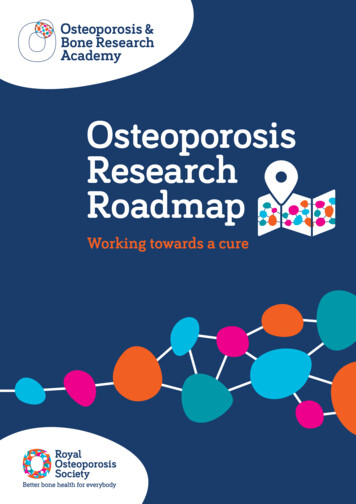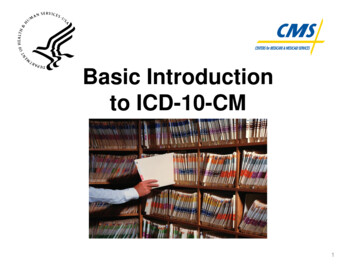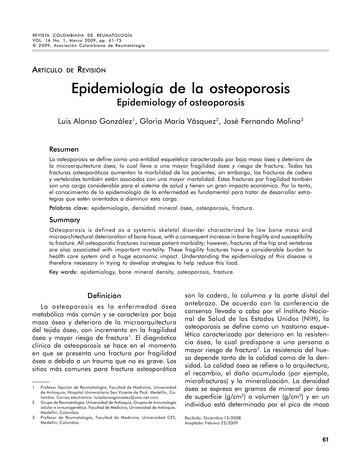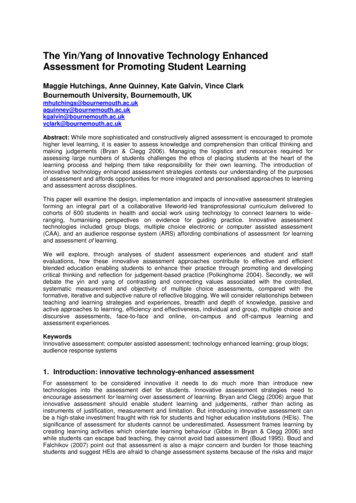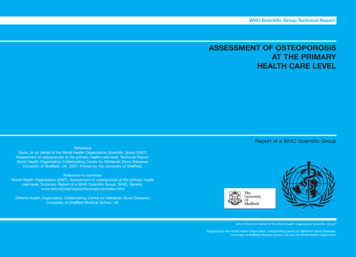
Transcription
WHO Scientific Group Technical ReportASSESSMENT OF OSTEOPOROSISAT THE PRIMARYHEALTH CARE LEVELReport of a WHO Scientific GroupReferenceKanis JA on behalf of the World Health Organization Scientific Group (2007)Assessment of osteoporosis at the primary health-care level. Technical Report.World Health Organization Collaborating Centre for Metabolic Bone Diseases,University of Sheffield, UK. 2007: Printed by the University of Sheffield.Reference to summaryWorld Health Organization (2007) Assessment of osteoporosis at the primary healthcare level. Summary Report of a WHO Scientific Group. WHO, tml World Health Organization Collaborating Centre for Metabolic Bone Diseases,University of Sheffield Medical School, UKJohn A Kanis on behalf of the World Health Organization Scientific Group*Organized by the World Health Organization Collaborating Centre for Metabolic Bone Diseases,University of Sheffield Medical School, UK and the World Health Organization
*WHO Scientific Group onAssessment of Osteoporosis at the Primary Health Care LevelMembers, observers and secretariatProf Philippe BonjourHopital Cantonal Universitaire de GeneveGeneva, SwitzerlandProf Juliet CompstonUniversity of Cambridge Clinical SchoolCambridge, UKProf Bess Dawson-HughesTufts UniversityBoston, USAProf Pierre DelmasHopital Edouard HerriotLyon, FranceMs Helena JohanssonWHO Collaborating Centre for Metabolic BoneDiseasesSheffield, UKProf John A Kanis (Chairman)WHO Collaborating Centre for Metabolic BoneDiseasesSheffield, UKProf Edith LauLek Yuen Health CentreHong Kong, ChinaDr Robert LindsayHelen Hayes Hospital, Rt 9WW Haverstraw, NY, USAProf L Joseph Melton III (Rapporteur)Mayo ClinicRochester, USADr Michael R McClungOregon Osteoporosis CenterPortland, USADr Anders OdenWHO Collaborating Centre for Metabolic BoneDiseases, Sheffield, UKDr Bruce PflegerChronic Respiratory Diseases & Arthritis (CRA)World Health Organisation, USAMr Ger TeilenTask Force Audern ArbeidDen Haag, The NetherlandsDr Patricia ClarkHospital de Especialidades Bernardo SepulvedaMexico City, MexicoProf Cyrus CooperSouthampton General HospitalSouthampton, UKDr Chris De LaetInstitute for Public HealthBrussels, BelgiumProf Claus GlüerKlinikum fur Radiologische DiagnostikKiel, GermanyProf Olof Johnell (Rapporteur)Malmo General HospitalMalmo, SwedenDr Nikolai KhaltaevChronic Respiratory Diseases & Arthritis (CRA),World Health OrganisationGeneva, SwitzerlandDr Mike LewieckiNew Mexico Clinical Research & OsteoporosisCenter, IncAlbuquerque, USAProf Paul T LipsVrije UniversityAmsterdam, The NetherlandsDr Eugene V McCloskeyWHO Collaborating Centre for Metabolic BoneDiseases, Sheffield, UKProf Paul D MillerColorado Center for Bone ResearchColorado, USAProf Socrates E PapapoulosLeiden University Medical CenterLeiden, The NetherlandsProf Stuart SilvermanDavid Geffen School of Medicine UCLABeverly Hills, USADr Natalia ToroptsovaInstitute of Rheumatology of RAMSMoscow, Russian FederationNOTE:THIS PAGE IS THEINSIDE BACK COVER
WHO Scientific Group Technical ReportASSESSMENT OF OSTEOPOROSISAT THE PRIMARYHEALTH CARE LEVELReport of a WHO Scientific GroupJohn A Kanis on behalf of the World Health Organization Scientific Group*Organized by the World Health Organization Collaborating Centre for Metabolic Bone Diseases,University of Sheffield Medical School, UK and the World Health Organization1
ReferenceKanis JA on behalf of the World Health Organization Scientific Group (2007)Assessment of osteoporosis at the primary health-care level. Technical Report.World Health Organization Collaborating Centre for Metabolic Bone Diseases,University of Sheffield, UK. 2007: Printed by the University of Sheffield.Reference to summaryWorld Health Organization (2007) Assessment of osteoporosis at the primary healthcare level. Summary Report of a WHO Scientific Group. WHO, tml World Health Organization Collaborating Centre for Metabolic Bone Diseases,University of Sheffield Medical School, UK2
Contents1.Introduction1.1Background1.2Risk factors1.3Model synthesis1.4Possibilities for the futureReferences669911122.Consequences of osteoporosis2.1Osteoporotic fractures2.2Incidence of osteoporotic fractures2.3Pattern of fractures2.4Mortality from osteoporotic fractures2.5Disability due to osteoporotic fracture2.6Global burden of disease2.7Future .Measurement of bone mineral and diagnosis of osteoporosis3.1Methods of assessment3.2Performance characteristics of bone mineralmeasurements3.3Definition of osteoporosis3.4Assessment of osteoporosisReferences5353596069704.Overview of clinical risk factors for fracture4.1Risk factors related to impaired bone strength4.2Risk factors related to excessive bone loads4.3Use of clinical risk factors for fracture predictionReferences75767881835.Identification of risk factors for case finding5.1Levels of evidence5.2Meta-analyses of risk factors5.3Summary of effects5.4Other risk factorsReferences8687901211261316.Combining risk factors for risk assessment6.1Population relative risks6.2Gradients of risk6.3Absolute probability of fractureReferences1441451491521663
7.Assessment tools for case finding7.1Population screening7.2Case finding7.3Prediction of osteoporosis7.4Prediction of fracture7.5WHO fracture assessment tool (FRAX )7.6External rvention thresholds8.1Types of evaluation8.2Selection of intervention thresholds8.3Intervention thresholds in the UK8.4Other socio-economic settings8.5Individual patient-based scenarios8.6Implications for case ent and therapeutic strategy9.1Population-based prevention9.2Case finding without measurement of measurementof bone mineral density9.3Case finding with measurement of bone mineraldensity9.4Selective use of measurement of bone mineraldensity with clinical risk factors9.5Resource implications for dual energy X-rayabsorptiometry9.6Implementation of assessment guidanceReferences23723824325125626627127610. Summary and conclusions, recommendations for research10.1 Consequences of osteoporosis10.2 Bone mineral measurements and diagnosis ofosteoporosis10.3 Clinical risk factors for fracture10.4 Assessment tools for case finding10.5 Assessment and the formulation of therapeuticstrategy10.6 Recommendations for research281281Acknowledgements286Annex 1Ten-year probabilities of hip fracture (%) in the UKaccording to age, sex and gradient of riskAvailable at www.shef.ac.uk/FRAX4282283284249286288
Annex 2Ten-year probabilities of hip fracture (%) in the UKpopulation according to age, sex and risk ratio295Available at www.shef.ac.uk/FRAXAnnex 3Ten-year probability of osteoporotic fracture (%)according to BMD, the number of clinical risk factors(CRF) and age.308Available at www.shef.ac.uk/FRAXAnnex 4Ten-year probability of fracture (%) according to BMI,the number of clinical risk factors and age.327Available at www.shef.ac.uk/FRAXAnnex 5Relationship between probability and hazard functions. 338Available at www.shef.ac.uk/FRAX5
1.IntroductionA WHO Scientific Group on the Assessment of Osteoporosis at the PrimaryHealth Care Level met in Brussels from 5 to 7 May 2004. The meeting wasopened by Dr N. Khaltaev, Responsible Officer for Chronic RespiratoryDiseases and Arthritis, who welcomed the participants on behalf of theDirector-General of the World Health Organization (WHO).1.1BackgroundFollowing the publication of the report of a WHO Study Group meeting onAssessment of fracture risk and its application to screening for postmenopausalosteoporosis, osteoporosis has been recognized as an established and welldefined disease that affects more than 75 million people in the United States,Europe and Japan (1). Osteoporosis causes more than 8.9 million fracturesannually worldwide, of which more than 4.5 million occur in the Americasand Europe (Table 1.1). The lifetime risk for a wrist, hip or vertebral fracturehas been estimated to be in the order of 30% to 40% in developed countries– in other words, very close to that for coronary heart disease. Osteoporosisis not only a major cause of fractures, it also ranks high among diseases thatcause people to become bedridden with serious complications. Thesecomplications may be life-threatening in elderly people. In the Americas andEurope osteoporotic fractures account for 2.8 million disability-adjusted lifeyears (DALYs) annually, somewhat more than accounted for by hypertensionand rheumatoid arthritis (2), but less than diabetes mellitus or chronicobstructive pulmonary diseases (Fig. 1.1). Collectively, osteoporotic fracturesaccount for approximately 1% of the DALYs attributable tononcommunicable diseases.Fig. 1.1Burden of diseases estimated as disability-adjusted life years (DALYs) in 2002 in theAmericas and Europe combinedSource: reference 2 (data extracted from Annex Table 3, pp. 126-131) and WHO unpublished data.6
Table 1.1Estimated number of osteoporotic fractures by site, in men and women aged 50 years ormore in 2000, by WHO regionExpected number of fracturesby site (thousands)ProximalSpinehumerusForearmWHO regionHipAfricaAmericasSouth-East AsiaEuropeEastern MediterraneanWestern 11971 6721 416706TotalAll osteoporoticfracturesNo.%1624830657452464751 4061 5623 1192612 5360.815.717.434.82.928.61 6608 959100Source: O Johnell & J A Kanis, unpublished data, 2006.aIncludes Australia, China, Japan, New Zealand and the Republic of Korea.Because of the morbid consequences of osteoporosis, the prevention of thisdisease and its associated fractures is considered essential to the maintenanceof health, quality of life, and independence in the elderly population. In May1998, the Fifty-first World Health Assembly, having considered The worldhealth report 1997: conquering suffering, enriching humanity (3), whichdescribed the high rates of mortality, morbidity and disability from majornoncommunicable diseases – including osteoporosis, adopted a resolutionrequesting the Director-General to formulate a global strategy for theprevention and control of noncommunicable diseases (4). A scientific groupmeeting subsequently reported on the prevention and management ofosteoporosis (5). The report of the present Scientific Group on Assessmentof Osteoporosis at the Primary Health Care Level is a further step in thedevelopment of cohesive strategies for tackling osteoporosis in response tothe World Health Assembly resolution (4). It is expected that the report ofthis meeting will lead to improvements in the assessment of osteoporosispatients throughout the world, and make a valuable contribution to thedevelopment of effective global strategies for the control of this importantdisease.Osteoporosis has been operationally defined on the basis of bone mineraldensity (BMD) assessment. According to the WHO criteria, osteoporosis isdefined as a BMD that lies 2.5 standard deviations or more below the averagevalue for young healthy women (a T-score of -2.5 SD) (1,6). This criterionhas been widely accepted and, in many Member States, provides both adiagnostic and intervention threshold. The most widely validated techniqueto measure BMD is dual energy X-ray absorptiometry (DXA), anddiagnostic criteria based on the T-score for BMD are a recommended entrycriterion for the development of pharmaceutical interventions inosteoporosis (7–9). Since therapeutic trials in osteoporosis usually require alow BMD value as an entry criterion, drugs are licensed for use in patients7
below a given BMD threshold. The implication is that BMD should beassessed before treatment is considered.There are, however, several problems with the use of BMD tests alone. Inmany Member States, BMD tests using DXA are not widely available, or areused predominantly for research, in part because of the high capital costs ofDXA. In other Member States, BMD tests are not reimbursed despite theavailability and approval of effective drug treatments. For this reason, manyother techniques for measuring bone mineral have been developed, whichhave lower costs and are more portable. The experience with several of theseis limited, however, and there is no clear guidance as to how these should beused with or without DXA, either for the diagnosis of osteoporosis or for theassessment of fracture risk. This report updates criteria for the diagnosis ofosteoporosis in the light of these developments.A second major problem with bone mineral measurement is that these testsalone are not optimal for the detection of individuals at high risk of fracture.Over most reasonable assumptions, the tests have high specificity but lowsensitivity (1). In other words, the risk of fracture is very high whenosteoporosis is present, but by no means negligible when BMD is normal.Indeed, the majority of osteoporotic fractures will occur in individuals witha negative test. Thus, the potential impact of widespread testing of BMD onthe burden of fractures is less than optimal, and this is one of the reasons whymany agencies do not recommend population screening of BMD (1,10,11).Current recommendations for the assessment of patients also have severaldifficulties. None is suitable for international use. Those produced bynongovernmental organizations are either conservative, e.g. the EuropeanFoundation for Osteoporosis guidelines (12), or border on a populationscreening strategy, e.g. National Osteoporosis Foundation of the USA(13–15). Both approaches rely critically on testing of BMD, and there is littleguidance for Member States without such facilities.In the past decade, a great deal of research has taken place to identify factorsother than BMD that contribute to fracture risk. Examples include age, sex,the degree of bone turnover, a prior fracture, a family history of fracture, andlifestyle risk factors such as physical inactivity and smoking. Some of theserisk factors are partially or wholly independent of BMD. Independent riskfactors used with BMD could, therefore, enhance the information providedby BMD alone. Conversely, some strong BMD-dependent risk factors can, inprinciple, be used for fracture risk assessment in the absence of BMD tests.For this reason, the consideration of well-validated risk factors, with orwithout BMD, is likely to improve fracture prognostication and the selectionof individuals at high risk for treatment.Against this background, WHO approved a programme of work within theterms of reference of the WHO Collaborating Centre at Sheffield. Theproject also had the support of the International Osteoporosis Foundation,8
the National Osteoporosis Foundation (USA), the International Society forClinical Densitometry and the American Society for Bone and MineralResearch. A position paper on the general approach was endorsed by theInternational Osteoporosis Foundation and the United States NationalOsteoporosis Foundation (16). The aims of the programme were to identifyand validate clinical risk factors for use in fracture risk assessment on aninternational basis, either alone, or in combination with bone mineral tests.A further aim was to develop algorithms for risk assessment that weresufficiently flexible to be used in the context of many primary care settings,including those where BMD testing was not readily available.1.2Risk factorsRisk factors for any osteoporotic fracture and for hip fracture were identifiedfrom 12 prospectively studied population-based cohorts in many geographicterritories using the primary databases. The cohorts included the EuropeanVertebral Osteoporosis Study (Pan-European), the Dubbo Osteoporosisstudy (Australia), the Canadian Multicentre Osteoporosis study (Canada),Rochester (USA), Sheffield (UK), Rotterdam (Netherlands), Kuopio(Finland), Hiroshima (Japan), the OFELY (L’os des femmes de Lyon) cohortfrom Lyon and the multicentre EPIDOS (Epidémiologie de l’osteoporose)cohort from France, and two cohorts from Gothenburg (Sweden). Thecohort participants had a baseline assessment documenting clinical riskfactors for fracture. Approximately 75% also had BMD measured at the hip.The follow-up was approximately 250 000 patient–years in 60 000 men andwomen during which more than 5000 fractures were recorded.1.3Model synthesisWork over the past few years has clarified many of the features necessary forimproved patient assessment. A central component is that the diagnosticcriterion for osteoporosis using the WHO definition is not always anappropriate threshold to identify patients at high fracture risk for treatment.The use of the T-score alone is inappropriate since age is as great a risk factoras BMD. Rather, thresholds should be based on a more global evaluation ofrisk, and in particular on that risk which is amenable to an intervention (i.e.modifiable risk). There are problems with the use of relative risks, and thesehave contributed to the view, now increasingly accepted, that the risk ofpatients for fracture should be determined according to absolute probabilityof fracture. A 10-year probability of fracture is preferred to lifetime risksbecause: Assumptions on future mortality introduce increasing uncertainties forrisk assessment beyond 10 years. Treatments are not generally given feasibly over a lifetime. The long-term prognostic value of some risk factors may decreasewith time. The 10-year interval accommodates clinical trial experience of9
interventions (generally 3–5 years) and the reversal phase (offset time)when treatment is stopped.Models have been created that are based on the hazard functions for fracturesand for death in Sweden, which are used to compute the long-termprobability of different fracture types. The models accommodate risk factorssuch as age, sex, BMD at the hip (femoral neck) and clinical risk factors thathave proven international validity.The first operational model was based on Sweden because of the robustnessand extent of the epidemiological data available in that country. Fracturerates, however, differ markedly in different regions of the world. Even withinEurope, the risk of hip fracture varies more than 10-fold between countries(17,18), and there is comparable variation in the rate of hospitalization forvertebral fracture (19). The lowest absolute risk of hip fracture is found inthe developing world, in part because of the lower fracture risk, but alsobecause of lower life expectancy.Notwithstanding, the general pattern of osteoporotic fracture is broadlysimilar across nations. Since extensive epidemiological data exist worldwidefor hip fracture, the methodology has been extended to quantify osteoporoticfracture probabilities where hip fracture rates alone are available. Thispermits probabilities of fracture to be quantified in many regions of theworld. Separate models have been constructed for countries with very highrisk (e.g. Scandinavia), high risk (e.g. western Europe), moderate risk (e.g.southern Europe) and low risk (e.g. the developing countries). The modelshave been validated in independent cohorts that did not participate in themodel construct.The choice of risk factors examined was governed by availability of data, andthe ease with which the risk factors might be used in primary care. Potentialrisk factors were examined by a series of meta-analyses using Poisson modelsfor each risk factor in each of the study cohorts and for each sex. Covariatesexamined included age, sex, BMD, time since assessment and the covariateitself, e.g. to determine whether BMD or body mass index (BMI) are equallypredictive for fracture at different levels of BMD or BMI. Results from thedifferent studies were merged using the weighted β-coefficients.Candidate risk factors included age, sex, glucocorticoid use, secondaryosteoporosis, family history, prior fragility fracture, low BMI, smoking,excess alcohol consumption, contraceptive pills, age at menopause, age atmenarche, hysterectomy, diabetes, consumption of milk and femoral neckBMD. Risk factors for falling were not considered, since there is some doubtwhether the risk identified would be modified by a pharmaceuticalintervention. Risk factors recommended for use were selected on the basis oftheir international validity and evidence that the identified risk was likely tobe modified by subsequent intervention (modifiable risk). Modifiable risk10
was validated from clinical trials (BMD, prior fracture, glucocorticoid use,secondary osteoporosis), or partially validated by excluding interactions ofrisk factors on therapeutic efficacy in large randomized intervention studies(e.g. smoking, family history, BMI).A further step was then to merge these meta-analyses of each risk factor sothat account could be taken of the interdependence of the risk factorschosen, and therefore the risk provided by any combination of risk factors,with and without the additional use of BMD.Assessment algorithms (FRAX ) have been developed for the prediction ofhip fracture and other osteoporotic fractures, based on clinical risk factorsalone, or the combination of clinical risk factors plus BMD, available atwww.shef.ac.uk/FRAX The FRAX algorithms are suitable for men andwomen. Guidance is given on the economic use of BMD where resources forBMD exist but must be used sparingly.Given that the probability of fracture can be quantified, information isrequired on the level of risk that is sufficiently high to merit intervention.This is a complex issue that depends on the wealth of Member States, theplace of osteoporosis in the health-care agenda and the proportion of grossdomestic product spent on health care, as well as on fracture risk. Againstthis background, intervention thresholds will vary markedly around theworld. Examples of intervention thresholds are provided, based on costeffectiveness analyses which can be tailored to national requirements. Therewill be some Member States where supportive programmes only areappropriate, such as attention to adequate physical activity, nutrition and theavoidance of smoking. In other Member States, case-finding can be based onthe use of clinical risk factors alone. In many developed countries, the clinicalrisk factors can be used with the selective use of BMD. There will besegments of society or countries where BMD will always be used. Theguidance in this report accommodates these very different approaches tocase-finding.1.4Possibilities for the futureUntil recently, osteoporosis was an under-recognized disease and consideredto be an inevitable consequence of ageing. Perceptions have changed sinceepidemiological studies have highlighted the high burden of the disease andits costs to society and health care agencies, as well as the adverse effects onmillions of patients worldwide. The past 15 years have seen majorimprovements in diagnostic technology and assessment facilities; it is nowpossible to detect the disease before fractures occur. This has been associatedwith the development of treatments of proven efficacy (4).The scope of this report is to direct attention away from the sole use of BMDto determine who will receive treatment and to shift towards the assessmentof absolute fracture risk, whether this be determined by BMD testing or11
other validated instruments. The use of clinical risk factors together withBMD provides a mechanism for the effective and efficient delivery of healthcare to individuals at high risk and the avoidance of unnecessary treatmentto others. The application of this approach may be expected to reduce,though not eliminate, the burden of osteoporotic fractures.Against this background, WHO has considered osteoporosis to be ofincreasing importance. The Director-General of WHO has stated that“WHO sees the need for a global strategy for prevention and control ofosteoporosis focusing on three major functions; prevention, managementand surveillance” (20). In order to amplify the existing and past activities ofWHO in osteoporosis, the object of this Scientific Group meeting was toreview the scientific basis for the identification of patients at high or low riskof osteoporotic fracture with or without the use of BMD. The aim was tooptimize the detection of high risk patients so that therapy can be betterdirected. The meeting did not consider specific pharmacologicalinterventions. Rather, the approach to be developed was a case-findingstrategy where risk factors are identified to quantify absolute risks.References1.Assessment of fracture risk and its application to screening for postmenopausalosteoporosis. Report of a WHO Study Group. Geneva, World Health Organization,1994 (WHO Technical Report Series, No. 843).2.The world health report 2004: changing history. Geneva, World Health Organization,2004.3.The world health report 1997: conquering suffering, enriching humanity. Geneva, WorldHealth Organization, 1997.4.Resolution WHA51.18. Noncommunicable disease prevention and control. In:Fifty-first World Health Assembly, Geneva, 11 –16 May 1998. Volume 1. Resolutionsand decisions, annexes. Geneva, World Health Organization, 1998(WHA51/1998/REC/1).5.Prevention and management of osteoporosis. Report of a WHO Scientific Group.Geneva, World Health Organization, 2003 (WHO Technical Report Series, No.921).6.Kanis JA et al. The diagnosis of osteoporosis. Journal of Bone and MineralResearch, 1994, 9: 1137–1141.7.Guidelines for preclinical and clinical evaluation of agents used in the prevention ortreatment of postmenopausal osteoporosis. Rockville, MD, Food and DrugAdministration, Division of Metabolism and Endocrine Drug Products, 1994.8.Committee for Proprietary Medicinal Products. Note for guidance onpostmenopausal osteoporosis in women. European Agency for the Evaluation ofMedicinal Products, London, 2001 (CPMP/EWP/552/95 rev. 1).9.Guidelines for preclinical evaluation and clinical trials in osteoporosis. Geneva, WorldHealth Organization, 1998.10.Report on osteoporosis in the European Community. Strasbourg, EuropeanCommunity, 1998.12
11.Osteoporosis: clinical guidelines for the prevention and treatment. London, RoyalCollege of Physicians, 1999.12.Kanis JA et al. Guidelines for diagnosis and management of osteoporosis.Osteoporosis International, 1997, 7:390–406.13.National Osteoporosis Foundation. Physicians guide to prevention and treatmentof osteoporosis. Excerpta Medica, 1998.14.Nelson HD et al. Screening for postmenopausal osteoporosis: a review of theevidence for the U.S. Preventive Services Task Force. Annals of Internal Medicine,2002, 137:529–541 and 526–528.15.Nelson HD et al. Osteoporosis in postmenopausal women: diagnosis and monitoring.Evidence Report / Technology Assessment No. 28 (Prepared by the OregonHealth and Science University Evidence-based Practice Center under contractNo. 290-97-0018). Rockville, MD, Agency for Healthcare Research and Quality,2002(AHRQ Publication No. 01-EO32).16.Kanis JA et al. A new approach to the development of assessment guidelines forosteoporosis. Osteoporosis International, 2002, 13: 527–536.17.Elffors L et al. The variable incidence of hip fracture in southern Europe: theMEDOS study. Osteoporosis International, 1994, 4: 253–263.18.Johnell O et al. The apparent incidence of hip fracture in Europe: a study ofnational register sources. Osteoporosis International, 1992, 2: 298–302.19.Johnell O, Gullberg B, Kanis JA. The hospital burden of vertebral fracture inEurope: a study of national register sources. Osteoporosis International, 1997, 7:138–144.20.Genant HK et al. Interim report and recommendations of the World HealthOrganization Task Force for Osteoporosis. Osteoporosis International, 1999, 10:259–264.2.Consequences of osteoporosisAge-related bone loss appears to be asymptomatic, and the morbidity ofosteoporosis is secondary to the fractures that occur.2.1Osteoporotic fracturesThe definition of an osteoporotic fracture is not straightforward. Irrespectiveof the methods used, opinions differ concerning the inclusion or exclusion ofdifferent sites of fracture. A widely adopted approach is to consider fracturesfrom low energy trauma as being osteoporotic. “Low energy” may variouslybe defined as a fall from a standing height or less, or trauma that in a healthyindividual would not give rise to fracture. The attribution can either be doneby coding fractures or by expert opinion, an approach that has been used inSwitzerland (1) and the United States of America (2,3). Thischaracterization of low trauma indicates that the vast majority of hip andforearm fractures are low energy injuries. At the age of 50 years,approximately 75% of people hospitalized for vertebral fractures havefractures that are attributable to low energy injuries, increasing to 100% by13
the age of 90 years (4). The consideration of low energy has the merit ofrecognizing the multifactorial causation of fracture, but osteoporoticindividuals are more likely to fracture than their normal counterpartsfollowing high energy injuries (5). As might be expected, there is also animperfect concordance between low energy fractures and those associatedwith reductions in BMD (6,7).The rising incidence of fractures with age does not provide direct evidence forosteoporosis, since a rising incidence of falls could also be a cause. Bycontrast, a lack of increasing incidence with age is reasonable presumptiveevidence that a fracture type is unlikely to be osteoporosis-related. Anindirect arbiter of an osteoporotic fracture is the finding of a strongassociation between the fracture and the risk of classical osteoporoticfractures at other sites. Vertebral fractures, for example, are a very strong riskfactor for subsequent hip and vertebral fracture (8–10), whereas forearmfractures predict future spine and hip fractures (11).The approach used here was to characterize fracture sites as osteoporoticwhen they are associated with low bone mass and their incidence rises withage after t
Mayo Clinic Rochester, USA Dr Michael R McClung Oregon Osteoporosis Center Portland, USA Dr Anders Oden WHO Collaborating Centre for Metabolic Bone Diseases, Sheffield, UK Dr Bruce Pfleger Chronic Respiratory Diseases & Arthritis (CRA) World Health Organisation, USA Mr Ger Teilen Task Force Audern Arbeid Den Haag, The Netherlands Dr Patricia Clark


